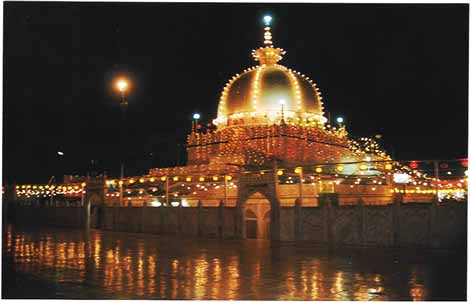
Jaipur, May 7: Khadims (priests) at the dargah (shrine) of Khawaja Moinuddin Chishti in Ajmer have decided not to assist Pakistani pilgrims in offering prayers at the shrine.
Several groups of khadims have decided to join the increasing protests against the killing of Sarabjit.
About 640 pilgrims from Pakistan will be visiting Rajasthan's Ajmer town later this week.
The pilgrims are expected to arrive in Ajmer May 12 to participate in the 801st Urs of Khawaja Moinuddin Chishti.
Ahead of the Pakistanis' visit, various organisations -- including the Vishwa Hindu Parishad, Shiv Sena and the BJP -- have been staging demonstrations in Ajmer, some 150 km from Jaipur.
The Pakistani delegation is likely to stay here for a week.
"We have decided not to assist any of the Pakistani pilgrims in offering prayers at the shrine. Prayers are not possible without khadims. We demand that the Indian government does not provide visas to any of the pilgrims," said a khadim.
He added that the visit could be a conspiracy by the Pakistani government to increase communal disharmony in India.
Another khadim, Natik Chisty, said the anger is brewing over Sarabjit's death, so visa should not be granted to Pak pilgrims.
The Shiv Sena staged a protest May 2 at the Ajmer district headquarters, demanding withdrawal of visas to the Pakistani group coming to Ajmer.
The Yuva Jat Mahasabha has also threatened to show black flags to Pakistani citizens in Ajmer.
The Urs is the annual event commemorating the death anniversary of Sufi Saint Khawaja Moinuddin Chishti at the dargah (shrine built over the grave). The Urs features night-long singing of qawwalis, and is held over 15 days. This time, the Urs will be held May 7 to May 22.
About five lakh devotees from different parts of the world participate in this event. This year, it is estimated that over seven lakh people will visit the city for the Urs.
The spiritual head of the 13th sanctuary shrine of Khawaja Moinuddin Chishti, Diwan Sayed Zainual Adebdin Ali Khan, had condemned the brutal attack that led to the death of Sarabjit Singh in a Lahore hospital, and said such an attack went against the tenets of Islam.





Comments
Add new comment